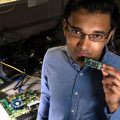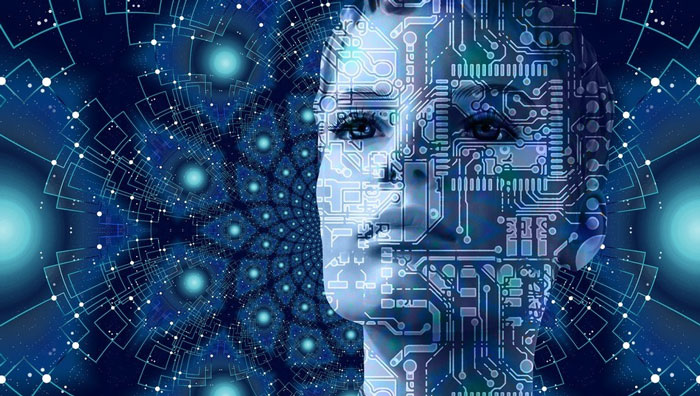
Artificial intelligence is a technology, or rather a direction of modern science that studies waystrain a computer, robotic equipment,it is reasonable to think the analytical system as a person. Actually, the dream of intelligent assistant robots arose long before the invention of the first computers.
Artificial Intelligence (AI), machine learning andneural networks - terms used to describe powerful technologies based on machine learning that can solve many problems from the real world.
Initially, functions such as thinking andComputers have not been able to make informed decisions, but in recent years several important discoveries have been made in the field of AI technologies and related algorithms. An important role is played by the increasing number of large samples of diverse data available for AI training — Big Data.
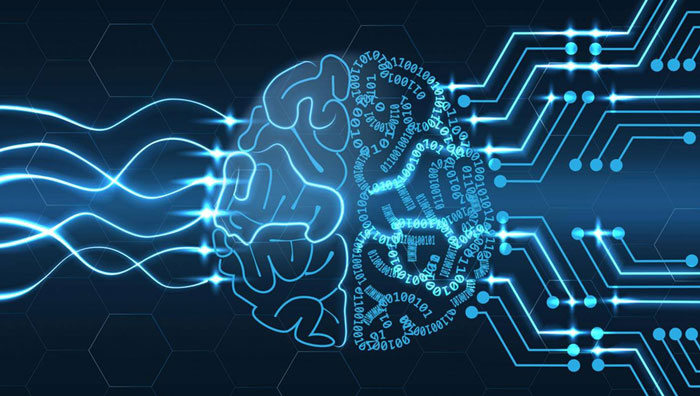
AI technology intersects with many othersareas including mathematics, statistics, probability theory, physics, signal processing, machine learning, blockchain, computer vision, psychology, linguistics and the science of the brain. Issues related to social responsibility and the ethics of creating AI attract interested people involved in philosophy.
The motivation for the development of AI technologies isthat problems that depend on many variable factors require very complex solutions that are difficult to understand and difficult to algorithmize manually. Modern machine learning and AI technologies, coupled with properly selected and prepared “training” data for systems, can allow us to teach computers to «think» for us — program, compose music, analyze data and make independent decisions based on them.
How does artificial intelligence (AI) work?
Artificial Intelligence is a capability.a digital computer or computer-controlled robot to perform tasks typically associated with intelligent beings. The term is often applied to the project of developing systems endowed with human-specific intellectual processes, such as the ability to reason, generalize, or learn from past experiences.
In simple words, AI is rudeimaging of neurons in the brain. The signals are transmitted from neuron to neuron and, finally, are output - a numerical, categorical or generative result is obtained. This can be illustrated by such an example. If the system takes a picture of a cat and is trained to recognize whether it is a cat or not:
- The first layer can identify common gradients that determine the overall shape of the cat.
- The second layer can identify larger objects, such as ears and mouth.
- The third layer defines smaller objects (such as a mustache).
Finally, based on this information,the program will print “yes” or “no” to say whether it is a cat or not. The programmer does not need to “tell” the neurons that these are the functions that they should look for. AI studied them by itself, training on many images (both with cats and without cats).
Description of Artificial Neuron
An artificial neuron is a mathematicalfunction conceived as a model of biological neurons, neural network. Artificial neurons are elementary units in artificial neural networks. Artificial neural networks were created as a mathematical model of the human brain. To do this, scientists Warren McCallock and Walter Pitts had to develop a theory of the activity of the human brain.
In it, individual neurons are livingcells with a complex device. Each neuron has dendrites - branched processes that can exchange signals with other neurons through synapses, as well as one axon - a larger process that is responsible for transmitting an impulse from a neuron. Part of the synapses is responsible for the excitation of a neuron, part - for inhibition. From what signals and through which synaptic connections will come to the “input” of a neuron, those impulses that it will transmit to other neurons will also depend.

For an artificial neuron, the physical carrier is notneeded. By and large, it is a mathematical function. Its task is to obtain information (for example, signals from many other artificial neurons), process it in a certain way, and then give the result to the "axon" - output. In an artificial network, neurons are usually divided into three types:
- input - each of these neurons receives an input element of input information (for example, one image point if the network recognizes photos);
- intermediate - process information;
- days off - produce the result (if the photo is recognized, the result may be the identifier of the displayed object).
The neural network itself is created in layers, like a pie.One of the outer layers contains input neurons, the other contains output neurons, and one or more intermediate ones can be located between them. Each neuron in the intermediate network is connected to many neurons from the two surrounding layers. Communication between neurons is ensured using weights - numerical values that each neuron calculates based on data received from the previous layer of the network.
Creating artificial neural networks, scientistsfocused on the structure of the human brain. Therefore, the principles of behavior of man-made neurons are not so different from real, living ones. Perhaps the mind, which can develop on the basis of such neural networks, will be close to the human?
The difference between artificial intelligence and human
Intelligence can be defined as general mentalability to reason, solve problems and learn. By virtue of its general nature, intelligence integrates cognitive functions such as perception, attention, memory, language, or planning. natural intelligence is distinguished by a conscious attitude to the world.
The question is how AI differs from naturalintelligence, in fact, lies more in the philosophical plane than in the strictly scientific. And the point is not that we cannot imagine what an artificially created mind will look like (or not). We can just imagine anything — and science fiction writers have proven it many times. The fact is that not a single artificial intelligence that exists today has reached a sufficiently high level of development to compete with humans on an equal footing.
There is a point of view expressed by a philosopherJohn Searle back in the 1980s. He coined the terms “strong AI” and “weak AI.” Strong artificial intelligence, according to the scientist, can be self-aware and think like a human. The weak are not capable of this.
Today's AIs, if you classify them bySherlu, clearly belong to the weak, because none of them have not yet arisen self-awareness. Our artificial neural networks recognize faces and draw strange, incredible pictures, read handwritten text and even add verses - but they were created exclusively for these purposes. None of these neural networks can change their minds and choose another “specialty” for themselves. They do only what they have been taught, and in a sense they can be considered programmed to perform these tasks. They do not have a genuine understanding of what is behind these things. Searle argued that building a strong AI was basically impossible.
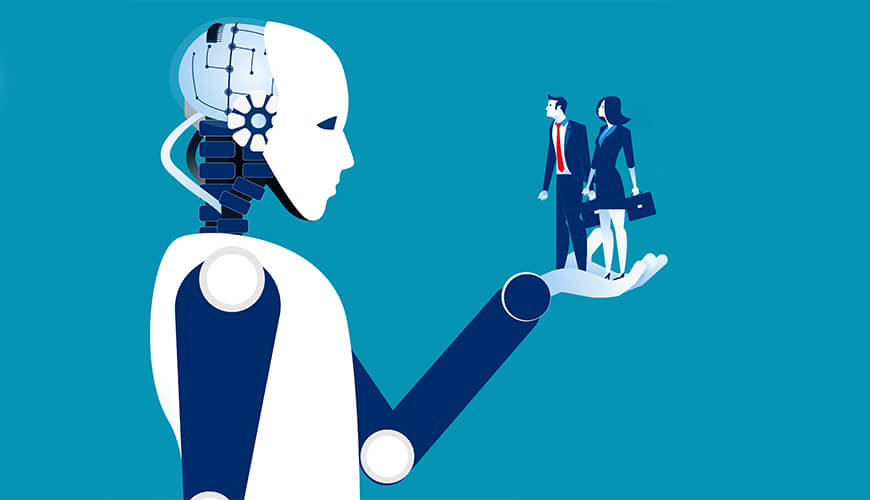
Another philosopher, Hubert Dreyfus, also believedthat computer systems can never be compared with a person - since in his rational activity he relies not only on acquired knowledge, but also empirical experience. Computers do not possess them by definition - therefore, it is not their fate to develop their own mind.
But these self-assertive statements were made intimes when neural networks took only the first steps. Today, looking at their successes in training, it is not difficult to believe in the reality of AI, which can become equal to a person, or even surpass him.
Basic principle of intelligence
Compare human thinking with artificialintelligence can be based on several general parameters of the organization of the brain and machine. The activities of a computer, like a brain, include four stages: coding, storage, data analysis and output.
The human brain and AI can self-learn independing on data obtained from the environment. The human brain and machine intelligence also solve problems (or problems) using certain algorithms.
The history of the development of artificial intelligence
The first work in the field of AI began inthe middle of the last century. The pioneer of research in this direction was Alan Turing, although philosophers and mathematicians began to express certain ideas in the Middle Ages. In particular, at the beginning of the 20th century, a mechanical device capable of solving chess problems was introduced.
But really this direction has formed tothe middle of the last century. The appearance of works on AI was preceded by research on the nature of man, ways of knowing the world around him, the possibilities of the thought process and other areas. By that time, the first computers and algorithms appeared. That is, a foundation was created on which a new line of research was born.
In 1950, Alan Turing published an article inwhich asked questions about the capabilities of future machines, as well as about whether they are able to get around a person in terms of rationality. It was this scientist who developed the procedure, later named in his honor: the Turing test.
After the publication of the works of an English scientistnew AI research has emerged. According to Turing, only that machine that cannot be distinguished from a person by communication can be considered as thinking. Around the same time that the scientist appeared, a concept came to be known as Baby Machine. It provided for the progressive development of AI and the creation of machines, the thought processes of which are first formed at the child's level, and then gradually improved.
The term “artificial intelligence” originatedlater. In 1952, a group of scientists, including Turing, gathered at Dartmund University of America to discuss AI-related issues. After that meeting, the active development of machines with the capabilities of artificial intelligence began.
A special role in the creation of new technologies in the field ofAI was played by the military departments, which actively funded this area of research. Subsequently, work in the field of artificial intelligence began to attract large companies.
Modern life poses more complex challenges.to the researchers. Therefore, the development of AI is carried out in fundamentally different conditions, if we compare them with what happened during the emergence of artificial intelligence. The processes of globalization, the actions of cybercriminals in the digital sphere, the development of the Internet and other problems - all this poses a challenge for scientists, the solution of which lies in the field of AI.
Despite the successes achieved in this area inrecent years (for example, the emergence of autonomous technology), the voices of skeptics who do not believe in the creation of truly artificial intelligence, and not a very capable program, have still subsided. A number of critics fear that the active development of AI will soon lead to a situation where cars completely replace people.
AI Research Areas
Philosophers have not yet reached a consensus onwhat is the nature of human intelligence, and what is its status. In this regard, in scientific works on AI, there are many ideas that tell you what tasks artificial intelligence solves. There is also no common understanding of the question of which machine can be considered reasonable.
Today, the development of artificial intelligence technologies goes in two directions:
- Descending (semiotic).It involves the development of new systems and knowledge bases that simulate high-level mental processes such as speech, expression of emotions and thinking.
- Ascending (biological).This approach involves carrying outresearch in the field of neural networks, through which models of intelligent behavior are created from the point of view of biological processes. Neurocomputers are being created on the basis of this direction.
What is a Turing test?
The Turing Test determines the ability of an artificial intelligence (machine) to think like a human.
In 1950, Turing published a paper“Computing Machines and Mind,” in which he discussed the theoretical possibility of thinking in machines. This was not the first research on the topic of artificial intelligence, or even Turing’s first such work, but it was the starting point for serious scientific discussions and debates.
Turing began with definitions to clarifythe question of whether the car can think - it seemed to him too blurry. What kind of car do you mean? What does it mean to “think”? .. It was obvious that such a question initially carries an irrational kernel that will not allow us to give the right answer. The result of the scientist’s thoughts was the Turing test - an experiment in which a person (“judge”) is invited to communicate with two interlocutors: a person and a computer. The judge’s task is to understand who is who. If, as a result, he is not sure which of his interlocutors the program is, or was mistaken in his assessment, it is considered that the machine passed the test.
The essence of the Turing test is not to createA "deceiving machine," capable of pretending to be human. It helps to make sure that a particular machine or program has a mind that is difficult to distinguish from human. Turing called such a computer “intelligent” - this definition is more than 60 years old, and it remains relevant.
The technological principles of artificial intelligence
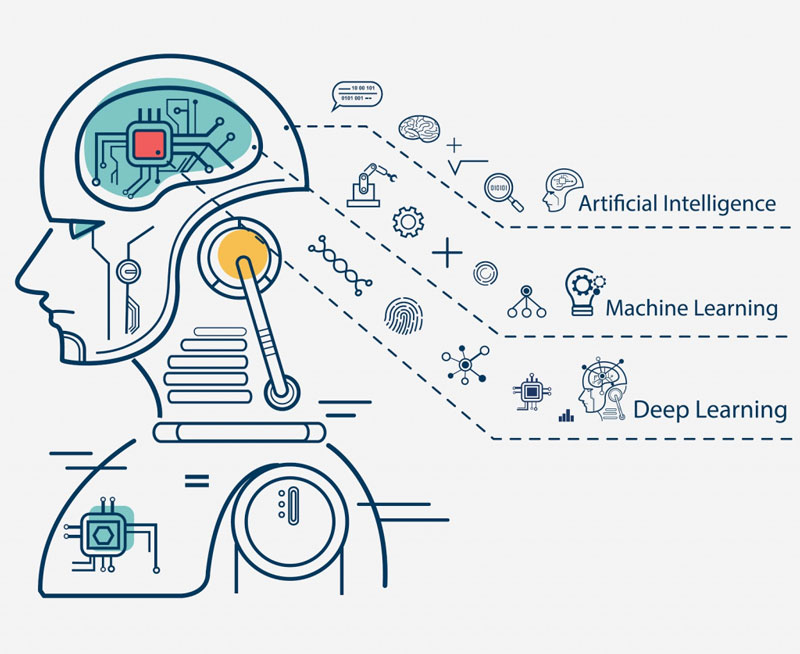
- Machine Learning (MO)– the principle of AI development based on self-learningalgorithms. Human participation in this approach is limited to loading an array of information into the machine’s “memory” and setting goals. There are several ML methods: supervised learning - a person sets a specific goal, wants to test a hypothesis or confirm a pattern. Learning without a teacher - the result of intellectual data processing is unknown - the computer independently finds patterns, learns to think like a person. Deep learning is a mixed method, the main difference is in the processing of large amounts of data and the use of neural networks.
- Neural network– a mathematical model that simulatesstructure and functioning of nerve cells in a living organism. Accordingly, ideally it is a self-learning system. If we transfer the principle to a technological basis, then a neural network is a set of processors that perform one task in a large-scale project. In other words, a supercomputer is a network of many ordinary computers.
- Deep learningclassified as a separate principle of AI, since thisthe method is used to detect patterns in huge amounts of information. For such work that is beyond human power, the computer uses advanced techniques.
- Cognitive computing- one of the areas of AI that studies andintroduces natural human-computer interaction processes, similar to interactions between people. The goal of artificial intelligence technology is to completely imitate human activity of the highest order - speech, imaginative and analytical thinking.
- Computer vision– this direction of AI is used forrecognition of graphic and video images. Today, machine intelligence can process and analyze graphical data and interpret information in accordance with the surrounding environment.
- Synthesized speech. Computers can already understand, analyze andreproduce human speech. We can already control programs, computers and gadgets with the help of voice commands. For example, Siri or Google assistant, Alice in Yandex and others.
It’s also hard to imagine existenceartificial intelligence without powerful graphics processors, which are the heart of interactive data processing. To integrate AI into various programs and devices, API technology is required - application programming interfaces. Using the API, you can easily add artificial intelligence technologies to any computer system: home security, smart home, CNC equipment and more.
The main problems of AI today
As you know, the possibilities of artificial intelligence at this stage of development are not unlimited. We list the main difficulties:
- Machine training is only possible on the basis of an array of data.This means that any inaccuracies in the information will greatly affect the final result.
- Intelligent systems are limited to a specific activity.That is, a smart system configured to detecttax fraud will not be able to detect fraud in the banking sector. We are dealing with highly specialized programs that are still far from human multitasking.
- Intelligent machines are not autonomous.To ensure their “life activity”, a whole team of specialists is needed, as well as large resources.
The limits of deep learning and neural networks
Despite all its advantages, deep learning and neural networks still have significant disadvantages.
- Data Dependence: In general, deep learning algorithms require a huge amount of training data to accurately complete their tasks. Unfortunately, in order to solve many problems, insufficient quality training data is needed to create working models.
- Unpredictability: neural networks are developing in some strange way. Sometimes everything goes as planned. And sometimes (even if the neural network does its job well), even the creators struggle to understand how the algorithms work. The lack of predictability makes it extremely difficult to eliminate and correct errors in the algorithms of neural networks.
- Algorithmic Offset: deep learning algorithms are as good as the data on which they are trained. The problem is that the training data often contains hidden or explicit errors or omissions, and the algorithms get them “inherited”. For example, a face recognition algorithm trained mainly in photographs of white people will work less accurately in people with a different skin color.
- Lack of generalization:Deep learning algorithms are good at performing targeted tasks but are bad at generalizing their knowledge. Unlike humans, a deep learning model trained to play StarCraft will not be able to play another similar game: say, WarCraft. Additionally, deep learning does not handle data that deviates from its training examples well.
AI technology applications
The scope of AI is wide enough andcover both familiar hearing technologies and emerging new directions, far from mass application, in other words, this is the whole range of solutions, from vacuum cleaners to space stations. All their diversity can be divided according to the criterion of key development points.
AI is not a monolithic subject area. Moreover, some of the technological areas of AI appear as new sub-sectors of the economy and separate entities, while serving most areas in the economy.
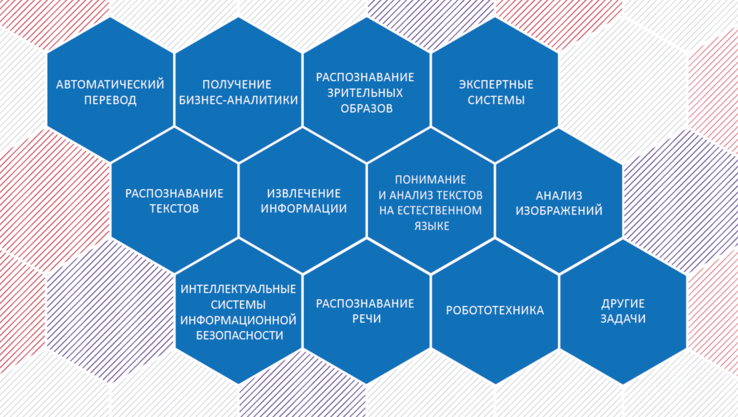
The development of the use of AI leads toadaptation of technologies in classical sectors of the economy along the entire value chain and transforms them, leading to the algorithmization of almost all the functionality, from logistics to company management. Undoubtedly, in the near future, artificial intelligence as well as cryptocurrencies will firmly enter our daily lives.
AI on the Internet
Whenever you say “Ok Google” or“Hi Siri,” you are turning to artificial intelligence in your smartphone. He is able to recognize speech addressed to him in the signal from the microphone. It records your question and forwards it to Google or Apple servers. There, a second AI is connected to the case, which recognizes speech and translates the question into a computer-understandable format. And then the third one searches for the answer through the gigantic databases. Finally, the answer returns to your smartphone, where the AI generating a human voice voices it for you. And all this in a split second.
AI in transport and logistics
Impressive applications of artificial neural networks- unmanned vehicles. Over the past decade, many automakers have undertaken to develop a car that would be able to independently navigate the roads - General Motors, Nissan, BMW, Honda, Volkswagen, Audi, Volvo, as well as Google and Tesla. Drones have not yet become a mass phenomenon on the streets of our cities, but they are clearly making progress.
Amazon has been developing an idea since 2013delivery of goods and mail using drones. The parcel first arrived at the recipient with an unmanned aerial vehicle in December 2016. In some regions, drones deliver food, medicine, and even portable defibrillators. The system is not perfect yet, but it continues to evolve. Unfortunately, drones can serve unlawful purposes: cases of delivering prohibited items to prisons with the help of drones, as well as the use of drones for transporting drugs, have been recorded.
AI in finance
In the financial sector, AI is used torisk forecasting, fraud detection. MasterCard Corporation, which created the international payment system, introduced the Decision Intelligence service several years ago. It is designed to improve the accuracy of confirmation of genuine transactions and reduce the likelihood of false payment declines - this is an erroneous operation of the built-in security system that does not allow a correct transaction to be completed, which is mistaken for a fraudulent one. Such errors harm both the seller, who loses the client, and the buyer, who does not receive the goods. The losses are even higher than the damage from fraud.
Artificial neural network systemuses information from many sources to assess on the fly how much the transaction is “normal”. It takes into account not only the reliability and transaction history of the seller, but even the typical purchase for the buyer and his location, as well as the time of day. All this helps to more reliably protect people from fraud and minimize false positives.
AI in medicine
AI develops in healthcare firstin the field of diagnosis of diseases. Artificial neural networks have learned to recognize cancerous tumors in X-ray, CT, mammography and MRI. An experienced doctor takes about 20 minutes to study a picture, and a neural network takes just seconds. So the patient can find out the results of the examination almost instantly. It is especially pleasant that such developments are also being carried out in Russia.
Diagnostic AI can detect not only cancer, but also the early stages of Alzheimer's disease, pneumonia and other diseases.
In defense and military affairs
In 2018, it became known that the US ArmyAI is being developed that can recognize human faces in the dark and even through walls using a thermal imager. The technology is expected to help identify gang leaders in war zones.
Another AI - ALPHA - was created to controlunmanned fighters and air combat. In one of the battles in the simulators, the computer won by simultaneously controlling four aircraft against two human opponents.
Aiming systems for tanks are also being developed that are capable of detecting camouflaged targets.
In the military-industrial complex, AI will help increase the defense capabilities of countries, but it can also become a weapon of terror.
In business and commerce
In retail, AI is revolutionizing. Artificial neural networks improve the quality of service and provide an individual approach to each consumer. Smart technologies detect bank card fraud, give personalized advice and help you pick up the goods.
According to TAdviser, in 2018, over a third of all retail revenues were generated through AI-based recommendations!
AI in sports
Here, AI technology is used topredicting match results - such systems were created by UBS, Commerzbank and Microsoft. The experience of the team and individual players is taken into account. Sometimes the predictions turn out to be correct, but often artificial intelligence is seriously miscalculated. The human factor is able to refute any predictions.
AI in culture
A machine cannot be creative because it has no imagination! Or maybe still?
Oddly enough, artificial neural networks are capable of being creative, and even reach certain heights in the field of culture.
Music
How would a flute sound if it were a sitar? Google's NSynth Super synthesizer uses the neural network to create completely new sounds based on a variety of instruments.
The Sony Flow Machines project goes further.Analyzing a selection of songs, an electronic composer develops his own original melody. In 2016, the company presented the single Daddy's Car, based on the music of The Beatles.
Alice, developed by the startup Popgun,knows how to “play along” with a person, creating musical improvisations. American singer Taryn Southern released an album co-authored with the Amper neural network. And the Endel project is capable of creating compositions that are in tune with the user’s mood at the press of a button.
Painting
The DeepDream neural network was created with an eye tofacial recognition, and she discovered a knack for surreal painting. The developers have opened a website where anyone can create an amazing canvas in collaboration with AI. The neural network paints pictures in different styles.
True, she doesn’t yet know how to come up with stories - she asks for human help.
Video
Using AI developed by Google and Facebook,you can “force” the person on the screen to utter any words and depict the entire range of emotions. And it can be difficult to distinguish such videos from real ones. Neural networks can even replace one actor with another in a filmed movie. And this opens up opportunities not only for filmmakers, but also for creators of fakes.
Literature
Facebook’s neural network can write poetry,perfectly maintaining the size and rhythm, choosing good rhymes. Readers only in half the cases were able to recognize the lines generated by the computer, but far from the real AI poets. The machine has not yet learned to convey emotions and invest in poetic works.
Yandex also launched “Autopoet”, whichcreated poems from user search queries. Some are impossible to read without smiling. It's hard to believe that they were created by a neural network with no sense of humor!
And Narrative Science has developedelectronic journalist. While the articles written by AI are simple in content, but the company's management is optimistic about the future and believes that by 2025 up to 90% of texts on the Internet will be written using machine intelligence.
In 2016, the book “The Day the Computer Writes a Novel” reached the final of the Hoshi Shinichi Japanese Literary Prize. This work almost completely created artificial intelligence.
Games
In computer games, neural networks are used tocontrol of opponents and game bots. But AI can be taught to play “on the other side of the screen” - that is, to read visual information from the screen and control the game character, as a person does.
In 2016, an AI championship was even held between AIDoom And the Deep-Q-Network system is trained to play Atari classic arcade machines. Often, it shows results up to 30% higher than experienced players.
In the 20th century, it was believed that artificial intelligencecan be considered quite powerful and developed when he manages to beat the world chess champion. Computers have passed this stage a long time ago - back in 1997, Deep Blue defeated Garry Kasparov (and it was an algorithmic program, not artificial intelligence).
After that, the attention of the public turned to morecomplex tactical games, such as go. The complexity of calculating the move here is an order of magnitude higher than in chess, so creating algorithms that would sort through possible options is almost impossible. But trained neural networks managed to cope with this game. Already in 2015, the Google-developed AlphaGo network won the match against a professional go player.
Prospects for the development of artificial intelligence in the future
Computers can now do a lot of thingswhat only people could do before: play chess, recognize letters of the alphabet, check spelling, grammar, recognize faces, dictate, speak, win game shows and much more.
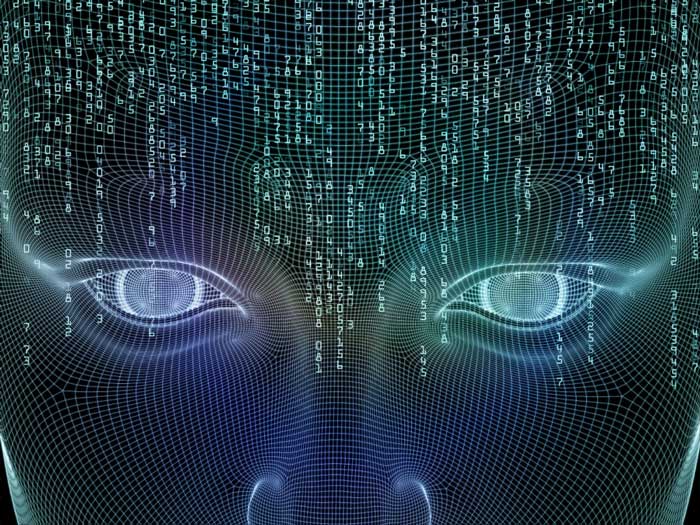
But skeptics persist. As soon as they manage to automate another human ability, skeptics say that this is just another computer program, and not an example of a self-learning AI.
AI technologies are only widely used andhave huge growth potential in all areas. Over time, humanity will create more and more powerful computers, which will be increasingly improved in the development of AI.
The purpose of AI is to put the human mind into a computer?
No, it is not. Even theoretically, such a situation is not so incredible. Artificial neural networks are created in the image of the human brain, although in a very simplified form. Maybe one day it will become possible to scan all sections of the brain of a living person, make a “map” of his neurons and synaptic connections and play a copy of it in a computer. From such a copied neural network one can expect not only rational behavior - it will literally be a double of a person, will be able to become aware of itself, make decisions and perform actions like him. Even memories are copied. Theoretically, it would be possible to place such a neural network in an artificial body (in a robot), and then a person - a copy of his consciousness - will be able to live almost forever.
In practice, such a transfer will beincredibly difficult: there are no technologies that would allow you to "read" the living brain and create its "map". And we are still very far from creating an artificial neural network that would be as powerful as the brain.
Does AI strive to achieve human intelligence?
The goal of AI is to help people and take over complex or routine tasks. To do this, he does not at all have to maintain conversations on philosophical topics or compose poems.
However, if artificial intelligenceonce able to reach the level of human thinking, this will be an important milestone for civilization. We will get a sensible and intelligent assistant - and we can rightfully be proud that this is the creation of our hands.
When will artificial intelligence reach the human level?
We successfully create relatively small neural networks capable of recognizing voices or processing images. No AI yet has the same plasticity as our brain.
A person can play music today, butTomorrow, take up C++ programming thanks to the incredible complexity of the brain. It has 86 billion neurons and countless synaptic connections between them.
Artificial neural networks are still far from achieving theseindicators: they have from several thousand to millions of neurons. There are technical limitations on the size of neural networks: even supercomputers will not be able to handle a neural network comparable in scale to the human brain. Not to mention that training her will be a non-trivial task.
The speed of computers allows them to possess intelligence?
The “power” of intelligence is not related to speedcomputing, but with the complexity of a neural network. The human brain is still superior in power to any artificial neural network, despite the fact that the speed of processes in it is significantly lower than in computers.
Artificial neural networks consist of individualneurons that are grouped into layers. The two outer layers serve as the “input” to which the initial information is supplied, and the “output” from which the result is read. Between them there can be from one to several tens, or even hundreds, of intermediate layers of neurons. Moreover, each neuron in a layer is connected to many others in the previous and next layers.
The more complex the network is, the more layers and neurons it has, the more large-scale and serious tasks it can perform.
Can a neural network develop naturally?
Let's see if it is likely that the AI will be able to receiveexperience and learn naturally as a child. The human mind is formed under the influence of many factors. We receive information about the outside world through the organs of perception - by observing, feeling, tasting. Interacting with the environment, we gain life experience, knowledge about the properties of the world, social skills. Our brain is constantly improving and physically changing, building up new synaptic connections and "pumping" existing ones.
If we can create a neural network, enoughdifficult so that it can develop in this way, and equip it with “sensory organs” - a video camera, microphone and the like - perhaps after a while she will be able to gain “life experience”. But this is a matter of the distant future.
How are computability theory and computational complexity related to AI?
Computational complexity theory focuseson classifying computational problems according to their inherent complexity and relating these classes to each other. A computational problem is a problem that can be solved by a computer. A computation problem is solvable by the mechanical application of mathematical steps such as an algorithm.
Share this material on social networks and leave your opinion in the comments below.
</p>Rate this publication




